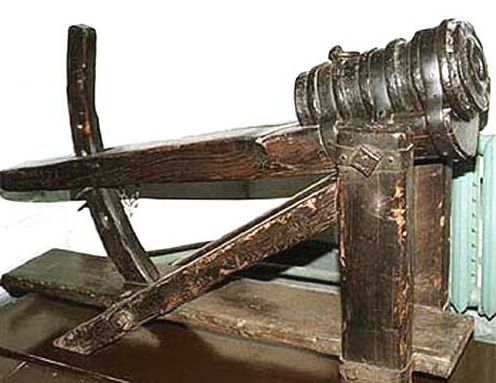(单词翻译:单击)
The history of human warfare is as storied as Game of Thrones and even more incestuously brutal.
人类战争史的故事性就跟《权力的游戏》一样精彩,甚至更血腥。
Time and again, the wisdom of the ages has been put to figuring out how to efficiently stab, maim, shoot, and in all other ways kill our enemies, and damn, are we good at it.
祖祖辈辈流传下来的智慧只为找出刺伤、致残、射杀的最佳角度以及其他各种能置敌人于死地的手段。哦这该死的技能,我们还挺擅长的其实~
But that's nothing new. In fact, those old guys in your history textbooks were just as imaginative as we are today at pounding foes into the dust. Forget Shakespeare. This is war.
然而杀人无新式。其实,历史课本里的那些老家伙跟我们一样,在如何撕碎敌人方面也是奇招百出。历史不是莎士比亚笔下的风花雪月,这是战争。
10.Greek Steam Cannon
10.希腊蒸汽大炮
In 214 BC, the Roman Republic laid siege to the Sicilian city of Syracuse in a bid to gain strategic control of the island.
公元前214年,罗马共和国围攻锡拉库扎的西西里市,妄图得到该市的战略控制权。
General Marcus Claudius Marcellus led a naval fleet of 60 quinqueremes—Roman battleships—across the Strait of Messina in a frontal charge while his second-in-command attacked from the land.
马库斯·克劳迪亚斯·马塞洛将军带领着一只由60只五段帆船组成的海军舰队——罗马战船——越过墨西拿海峡正面进攻西西里市,而他的副司令则从陆地入手。
But as the noose tightened around the city, the mighty Roman army found itself repelled by an unlikely adversary: Archimedes.
水陆两军逐渐收紧包围圈,然而强大的罗马军团发现他们败给了自己丝毫不放在眼里的阿基米德。
For everything the Romans threw at him, Archimedes was always three steps ahead. Ballistae on the outer walls tore through the advancing cavalry.
无论罗马军团如何行动,阿基米德总能先其三步。城墙上的投石机撕裂了前进的军队。
Seaward, the Claw of Archimedes lifted whole ships out of the water and shattered them in a shower of splinters and screaming slaves.
海边,阿基米德之爪将战舰整只吊起然后撞向海面,残木碎板满天飞溅,奴隶的惨叫更是不绝于耳。
For two years, the siege dragged on, an epic battle of military might versus scientific wit.
围歼就这么拖了两年,这场史诗般的军事斗争所用的计谋可与当今科学智慧媲美。

During this siege, Archimedes was said to have devised a weapon so devastating that it was able to burn ships to cinder from 150 meters (500 ft) away. All it took was a few drops of water.
据说,阿基米德在这场战争中发明了一种威力超强的武器,仅用几滴水就能把150米(500英尺)外的船只化为灰烬。
The device was deceptively simple: a copper tube heated over coals with a hollow clay projectile dropped down the barrel.
装置看似非常简单:在煤上加热的铜质炮管发射出空心泥制发射弹。
When the pipe got hot enough, a tiny bit of water was injected into the tube below the projectile.
当铜管达到一定温度时,往发射器底下的铜管注入少量水。
The water instantly vaporized, blasting the projectile toward advancing ships. On impact, the clay missile exploded, spraying burning chemicals onto the wooden ships.
水立马蒸发,产生的蒸汽压力便将"子弹"射向敌军。泥制炮弹在冲击力的作用下炸裂,包含其中的易燃化学物质随即洒满整只木船。
Even today, Archimedes's steam cannon is a matter of intense speculation.
直到今天,人们对阿基米德的蒸汽大炮依然猜测不断。
Mythbusters gave it a bust, but a team at MIT was able to build a working—and highly effective—model using the original description of the cannon.
"流言终结者"们尽泼冷水,但麻省理工学院的一个团队根据阿基米德蒸汽大炮的原始特征描述,成功仿造出了一个实际操作性非常强的模型。
They calculated that their .45-kilogram (1 lb) metal shell was launched with 1.8 times the kinetic energy of an M2 machine gun firing a .50-caliber round.
根据他们的计算,45千克(1磅)的金属炮弹的动能是勃朗宁M2重机枪的1.8倍。
If they hadn't shot it directly into a wall of dirt, they guessed that it would have had a range of 1,200 meters (4,000 ft). And they only used half a cup of water.
若非将炮弹发射到泥墙上,科学家们猜测它的射程能达到1200米(4000英尺)。而这仅是半杯水的作用。
9.Whirlwind Catapult
9.旋风炮
Catapults are the age-old war machines, and like modern rifles, there was a different kind for every purpose.
石弩是一种有历史的武器,和现代来福枪一样,它也有不同种类,用途不一。
While films have shown us the wall punchers and beast machines used by Greek and Roman armies, the Chinese devised a smaller version that could strike important targets with pinpoint accuracy: the xuanfeng, or whirlwind catapult.
我们在电影中看过许多希腊和罗马的军队武器:击墙机和野兽机器,而中国却发明了体积更小、命中率更高的版本:旋风炮。
Like a sniper rifle, the whirlwind catapult was a one-shot, one-kill form of attack.
跟狙击步枪一样,旋风炮也是一发一弹。

They were small enough to be quickly moved around a battlefield, and the entire catapult could be swiveled on its base while someone sighted out a target.
它体积小,便于在战场上快速挪移。一旦发现目标,整个弹射器可以围着基座旋转发射。
This gave them a strategic advantage over heavier catapults and trebuchets which, while much more destructive with a single shot, took time and manpower to maneuver into position.
与笨重的大型投石机或石弩相比,旋风炮占尽优势。尽管前者威力更大,但操作起来要耗费相当的时间和人力。
To add to their deadly accuracy, the Chinese built these whirlwind catapults with two sling ropes and two release pins, keeping the sling pouch perfectly centered in the middle. No other cultures were known to do that.
为了提高命中率,中国的旋风炮各有两条吊索和两个活动插销,使弹袋完美地固定在中间。还没有任何国家能做到这一点。
8.Rocket Cats
8.火箭猫
Nobody had ever heard of rocket cats before 2014. Nobody, that is, except for Franz Helm, the man who invented them.
2014年以前,没人听说过《火箭猫》。当然,除了作者弗兰兹·赫尔姆。
Sometime around AD 1530, the artillery master from Cologne, Germany, was putting together a military guide to siege warfare. Gunpowder was just beginning to have an impact on warfare, which made the book popular.
大约是公元1530年,这位来自德国科隆的火炮大师开始投入攻城战的军事指挥中。当时,由于火药对战争的作用逐渐显现,该书也流行起来。
Helm's manual contained descriptions of nearly every kind of bomb imaginable, all of it colorfully illustrated and grimly outlandish.
赫尔姆的手册中描述了几乎所有人们能想象到的炸弹种类,插图配得色彩鲜艳却让人感觉阴森诡异。
Then he added a section advising siege armies to find a cat. Any cat will do, he said, as long as it came from the city you were trying to vanquish.
随后他增加了一个章节,建议攻城部队找一只猫。他说,任何猫都可以,只要是从目标城跑出来的。

Then tie a bomb to it. In theory, the cat would scamper back to its home and subsequently burn down the entire city. Pigeons were fair game, too.
抓住它,然后绑上炸弹。理论上,猫会受惊跑回家,这样就能烧毁整个城市。鸽子也可作此用途。
Whether or not these things actually happened is a question that people are still trying to answer, but the answer is "probably not."
当然,人们对证实这些武器是否曾真实用于攻城这一问题始终热情不减,但答案很可能是否定的。
According to Mitch Fraas, a researcher at the University of Pennsylvania who had the pleasure of being the first person to translate the text, there isn't any historical evidence that anybody actually tried to do what Helm suggested.
宾夕法尼亚大学的研究员米奇·弗拉斯这位有幸成为该文本翻译的第一人表示,没有任何历史证据说明有任何人曾按照赫尔姆建议的去做。
The most likely result of such a scheme, he said, would be setting fire to your own camp.
他说该计谋极有可能会烧毁己方的营地。


